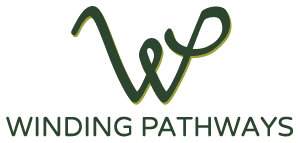by Winding Pathways | Nov 28, 2015 | Birds, Children/Play, Labyrinths, Nature, Travel/Columns, Wonderment
-
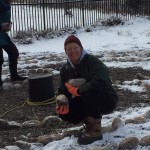
-
Lisa organizing the build.
-

-
Hudson, WI, has a new labyrinth at Healing Waters Health Center. Created by Lisa Gidlow Moriarty and assisted by several volunteers.
-
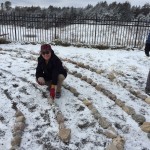
-
Carefully laying stone in the new labyrinth
What fortune to have contacted Lisa Gidlow Moriarty who was constructing a labyirnth at Healing Waters Health Center in Hudson, WI. Rich and I joined the crew and after the lines were drawn using high technology of a bucket and rope and a tire iron to gouge the circuits, we placed rocks that had been hauled in. The concentric circuits quickly asserted themselves and the labyirnth was completed in no time at all! The day was cold, but the hearts and spirits warm. What a fun experience.
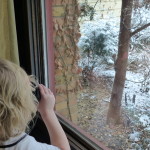
The children are quick to spot birds and squirrels.
Time with extended family in the Twin Cities was restful and hilarious as the children explored outside, spotted birds with “noculators”, and constructed wonderful toys from Legos.
Thanksgiving morning four of us walked a lovely labyrinth at St. Patrick’s Catholic Church in Plymouth, MN. Set down in a barrow area, the labyrinth is formal, well-maintained and has a light feel to it. While set apart, it is visible and still private. Well done.
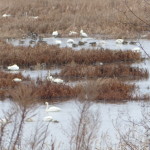
Along the Mississippi
Our drive back along the Mississippi River yielded a fabulous view of Tundra Swans near Minneiska, MN, and a really terrific lunch at a humble looking (on the outside) but spectacular on the inside creamery now restaurant, wine tasting stop and cheesery near Alma, WI. Pretty fabulous. And, the countryside of The Driftless” area (NE Iowa, NW IL, SE MN and SW WI) is gorgeous even on grey November days. Decorah, IA, boasts are pretty great coffee shop and small businesses.
by Winding Pathways | Nov 16, 2015 | Reflections/Profiles, Travel/Columns, Wonderment
Winding Pathways usually blogs about wondrous happenings in backyards. It’s normally rural news about plants, wildlife and weather. Here’s a change from the Big Apple, America’s largest city.
In the midst of rush hour on November 10, on my way back to Iowa after a difficult visit, I, (Rich) took a bus from New Jersey to New York’s Port Authority. When the driver opened the door bus occupants flowed into a river of humanity snaking its way through the monstrous terminal-along corridors, down escalators and through more corridors, until finally we were outside by the New York Times Building.
Needing to find the shuttle to LaGuardia Airport I went to where I thought it would be. No luck. No shuttle. Rather frazzled and running short on time I found a young policeman and asked where the Airport shuttle was. He said, “You look tired. Just follow me”. He delivered me to the shuttle ticket guy.
Then something truly “New York” happened. After buying a ticket and getting seated on the shuttle the driver entered. He was a tiny Asian man who looked to be about 15 years old but certainly was older. I’d be surprised if he weighed 100 pounds and he spoke no English. A blond woman sitting near me also spoke no English. She may have been Scandinavian and could not find the proper ticket in her purse. She and the driver were not able to communicate, so the young driver exited and soon came back with a bus employee with a deep Southern accent who was about three times his size. She politely pointed to the proper ticket nestled with many others in the European woman’s purse.
Everyone smiled as the passenger handed her ticket to the driver. We were soon off to LaGuardia Airport with the young driver ably worming the bus through Manhattan’s snarly traffic.
Three people. None shared a common language. All wanted a positive outcome…….and that happened. It was wondrous.
by Winding Pathways | Dec 16, 2014 | Nature, Travel/Columns, Trees/Shrubs
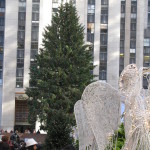
Rockefeller Center is the site of an amazing Christmas Tree that overlooks the skating rink in NYC.
Although increasing numbers of Americans are opting for an artificial Christmas tree, millions enjoy bringing a real tree into their homes for the festive season. As the fashions wax and wane, we see an upsurge in families eagerly venturing out to tree farms to select and cut a real tree. Many species of evergreens are used for Christmas trees but the following species are by far the most common:
EASTERN WHITE PINE: This is the great pine of New England and the upper Lake States that was logged to near oblivion in the late 1800s. It can grow to over 200 feet tall. Thankfully many survived and today the white pines are often used for Christmas Trees in the East. The natural range of the Eastern White Pine is from Southern Canada down to the Mid-Atlantic states and west to about Iowa. It has been widely planted outside its native range and a similar species, the Western White Pine, lives in northern Idaho and nearby Montana and Washington. White pines grow relatively rapidly and have five long soft needles in a bunch.
SCOTS (or Scotch) PINE: This fast growing but usually short lived tree has become increasingly popular as a Christmas tree. They are usually cut when only five or six feet tall, making them ideal for smaller houses and apartments. The species is native to Europe and is the most widespread pine in the world. It has several subspecies. Scots pine has two short twisted and somewhat stiff needles per bundle. On large trees the upper trunk bark is sometimes bright orange.
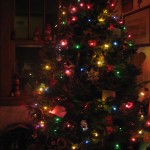
The soft glow of lights on a cold winter’s night warms our hearts.
BALSAM AND FRASER FIRS: This traditional Eastern tree is native to the cool moist north woods. Widespread in upper New England and Eastern Canada its range extends south along the Appalachian Mountains and west to Iowa. One of the slower growing conifers it has the wonderful evergreen fragrance that many people associate with Christmas. A similar tree, called the Fraser Fir, looks almost the same but the underside of its needles is silvery. It is native to the southern Appalachians. Both the Balsam and Fraser Firs have very short needles. These are by far favored Christmas Trees in the North East and along the East Coast.
OTHERS: Ponderosa pines and Douglas Firs are native to many western states and are often used for Christmas trees. A smattering of other pine, spruce, and fir species are also occasionally used.
In the East most people purchase a tree, but out west it’s more common for a family to make an outing to cut a wild tree. Occasionally, a family will bring a cedar, arbor vitae, or even a dried tumbleweed home to decorate as a Christmas “tree”.
